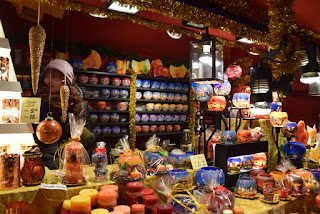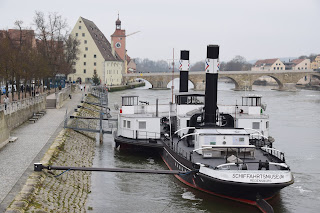An unusual alignment of the
planets meant that most of our increasingly growing family were going to in-laws
rather than descending on Canberra for the festivities. This meant we were free to do our own thing. Helen quickly decided that facing only me at Christmas dinner was not an option and that we should grab the opportunity for a cold Christmas and experience Northern
Hemisphere Christmas Markets.
After a quick 30 hour or so
flight we found ourselves in Nuremberg, Germany. Our hotel was a 5 minute walk
from one of the largest Christmas markets in the world. All of which is within
the walls of a beautiful city with some complex history.
The markets have everything
for sale from beautifully colourful vegetables and fruit
to table lights and candles
and back-lit houses. Although
it was cold the snow was limited to a backdrop sheet…
The variety was enormous.
Ever seen a pencil being made by hand? Here is the Staedtler shop.
Everywhere the nostrils were
treated to a range of mouth watering smells of which roasted chestnuts,
gingerbread and the numerous Gluhwein stalls could not be resisted. Our pick of
the Gluhwein stalls was this one with a warming glow.
Pretty warming on the inside as well (and we now have some
souvenir Nuremberg mugs).
Apart from eating (and you
have to keep your energy levels up in such a cold climate) we did give our mind
a workout as there is so much heritage. Albrecht Durer (1471 – 1528) was one of
the few artists in the world who made a decent living from his profession. His
house is now a small museum.
His self portraits were
unusual for the period not least of all because of their Christ like qualities.
There were a range of these in various formats including this enlarged print of
his head. His income however initially came from illustrating books and printing
presses.
Back outside the market lights
were warming. The steps of the church in the background was a stage for various
choirs that gave a great background atmosphere as we weaved our way through the
alleys formed by some 200 stalls.
The river frontage also had similarly attractive and enticing lighting.
The old city is bounded by a
huge wall and gates which have been carefully refurbished following the
destruction during WWII. The permanent lighting here is not so warming but is evocative.
This clock tower had a huge sculpture
at its base entitled “Marriage Merry-Go- Round fountain”. Unusually it had
contrasting white and black marble. Some of the sculptures were a little disturbing
and close ups were not considered appropriate for this blog!
The top gate has a labyrinth
like series of walls and buildings which were beautifully lit up.
After a couple of nights
(planned to help overcome jet lag) we boarded the River Princess for a cruise to
Budapest. The cold evenings precipitated a bit
of fog so the blue lights on the ship were a good beacon.
Inside was definitely ship
shape!
Outside is an interesting
story. We were moored on the Main-Danube canal which enables barges to travel
from Rotterdam on the North Sea all the way to Sulina on the Black Sea. The canal
is 171 kms but results in a total distance between the North and Black Seas of
3500 kms. By comparison going by sea around Gibraltar is over 7300 kms.
The canal has some 16 locks
with rises of up to 25 metres and tops out at 406 metres which is the highest
of any commercial waterway in the world. The locks are huge and at 190 m long
and 12 m wide somewhat dwarf our more familiar English locks of 70 ft by 7 ft!
Unlike the UK system which
are largely operated by the boat's crew these locks are operated remotely by a
couple of people in each of four locations. Big brother is definitely watching!
Here is a map.
Some of the double length
barges, once they leave a lock, take quite a bit of time to get up to speed so patience
is required.
Our ship had external controls either side of the wheelhouse so you can see how close you are to the lock walls. The captain took one
side while I took the other…..
The gates range from the
conventional two doors to single flat gates that rise up so that you can sail
under. Their drops are quite imposing especially when you think of the amount
of water that is backed up behind the upper lock door.
Engineering marvels were not
limited to the locks. Near Essing we went under this ludicrously profiled
bridge. At 189 metres it is the longest timber bridge in Europe and has a 73
metre central span. Needless to say it is only for foot traffic.
We docked for 24 hours at
Regensburg – right next to Villa Park. (For those not in the know this name is
normally associated with Aston Villa’s football stadium in Birmingham.)
The town is where the canal
meets the Danube. The river here runs at a staggering speed. I suspect the
paddle steamer tugboat Ruthof / Érsekcsanád must have had some fun negotiating
the river but is now a permanent mooring housing a nautical museum.
It makes a great foreground
to the cathedral.
Regensburg was one of the few
towns in Germany that did not suffer major damage in the war. Its Roman
heritage is still apparent in several locations. The stone blocks used in the
wall and gates were huge and would have needed Roman ingenuity (which is where
the term engineer comes from!) to transport them to site as well as during construction.
The 12th C bridge was undergoing
refurbishment when we visited. It remains a bit of a mystery how the piers were
built in such fast flowing waters given the equipment that was available at the
time.
The cathedral really does
dominate the skyline.
Refurbishment of the North
end of the bridge is complete and the result is particularly attractive as well as being safer.
Back in town we participated
in a walking tour. The town has some wonderful Baroque architecture built in
wealthy times. Fortunately, it also went through some very poor times and this
meant there was not money to demolish and rebuild buildings so the original
architecture largely remains in tact. The town has over 1500 heritage listed
buildings.
A couple of interesting
points were the standard measure of length next to the town hall in the
merchant part of the city. The three vertical rods are the foot, yard (centre
of the body to the fingertips) and fathom (distance spanned by outstretched arms).
There is even a little lucky mouse that you can touch and it
will ensure you return to the city!
We spent Christmas Eve here
and attended an evening mass at the cathedral which was packed for the occasion.
The choir did the right thing by walking through the crowd and presenting a
couple of hymns amongst those of us at the rear before weaving their way to the
front.
Wonderful voices, resounding
organ and colourful well lit cathedral. Just a shame it was so ….. cold!!
































